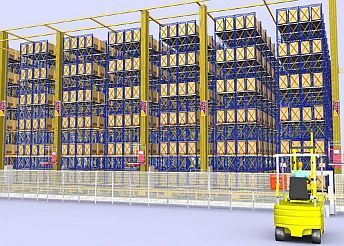Automation is nothing new in the manufacturing and distribution industry. After all, robots have been helping out on production lines since the 1970s, from shuttling parts to constructing car chassis. But the latest wave of automation is both more autonomous and more mobile than ever before – and it’s already at work in a facility near you. Here’s what you need to know about robots and storage, or what’s known as an automated storage and retrieval system (AS/RS). An AS/RS is a computer-controlled system that’s designed to locate, place and retrieve loads from racking and other storage. An AS/RS usually operates with complete autonomy, although it will tend to have some human oversight. In large scale operations, the AS/RS will receive its orders automatically in conjunction with an eCommerce system, and will set to work retrieving the items in question. The AS/RS concept has been around in some form since the 1960s. You may recognise the concept from depictions of archives in science fiction: a robot on a shuttle, lift or crane navigates a line of shelves, plucks out an item, and returns it to the operator. Many of today’s systems operate in a similar fashion, though their abilities have increased: modern systems can now pick smaller, more delicate items, and do so with dramatically improved speed. The most common automated storage systems operate by moving autonomous vehicles along guided rollers alongside shelves. When they are in position, a series of lifts carry the vehicle up to the correct pallet, which is then withdrawn from the shelf and ferried back. This is often quicker and always safer than involving employees in the retrieval process, and allows human resources to be distributed elsewhere in the business. An AS/RS using lifts is also known as a Vertical Lift Module (VLM). A VLM allows for storage on more levels than are traditionally available in a pallet racking solution, with the potential for eight or more tiers of as much as 100 ft tall. Such a system can accommodate over 14,000 pallets in just 30,000 square feet of floor space – saving up to 70,000 sq/ft saving on a traditional three-tiered layout. The efficiency savings this provides can then be reinvested in further internal and external expansion for production or distribution purposes. Amazon’s Kiva robots represent the current pinnacle of this technology. These squat, heavy lifting robots are what’s known as Unit Load AS/RS, and are more reminiscent of giant Roombas than your stereotypical robot. They’ve proved so efficient however that Amazon has rolled them out to its global warehouses, and they now help to manage the bulk of its Amazon Pantry stock. The robots are able to navigate down aisles of racking without collisions, and can locate pallets by scanning QR codes, a blocky barcode like image. They can then lift an entire pallet on their ‘back’, and carry it to human workers to open and pack the contents. All of this is carried out autonomously based on order volume for various products, and is only overseen by a human controller. The development of both sensor and wireless technology has dramatically altered the capabilities of an AS/RS. Advanced sensors similar to those used in autonomous cars prevent the robots from colliding with storage units or people, ensuring safe retrieval. The ability to grip and locomote with greater dexterity has also allowed for smaller objects to be transported, and the development of what are known as Mini-Load AS/RS. Wireless technologies such as RFID, Wi-Fi and NFC meanwhile allow the units to communicate information wirelessly, locating objects which have been tagged with visual codes or microchips. They can then tell a centralised system when they have successfully retrieved the item, automating the inventory management process with absolute accuracy. Automated storage and retrieval systems have a number of requirements which may be beyond smaller businesses; these include heavy health & safety oversight, centralised inventory management and eCommerce systems, and significant capital investment. Many businesses may benefit instead from the installation of more efficient, high density pallet racking, or the space saving effects of a mobile shelving solution. For those at the cutting edge, however, AS/RS represents the pinnacle of efficiency savings in storage and distribution, and something to keep a watchful eye on for the future. This post was written by Invicta Pallet Racking. For over 25 years we have been at the forefront of the archive storage industry throughout the UK and Europe, designing and installing some of the largest racking and storage systems currently found on the market.










